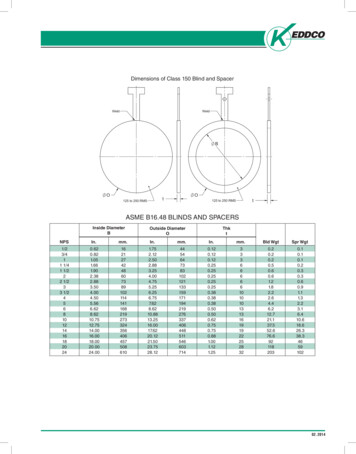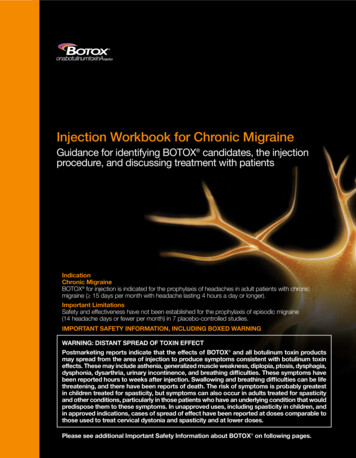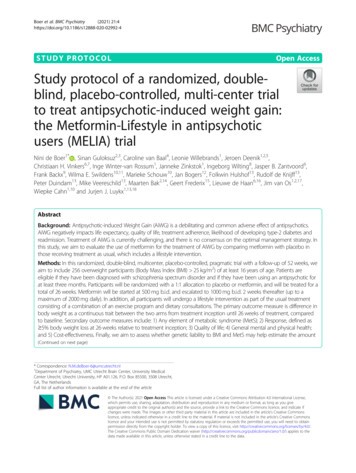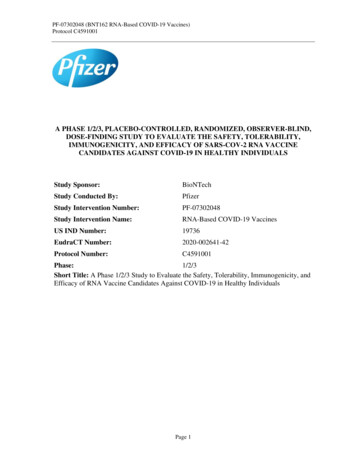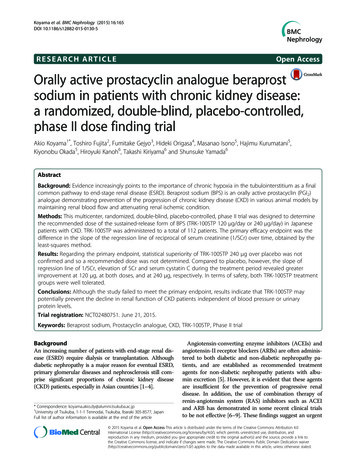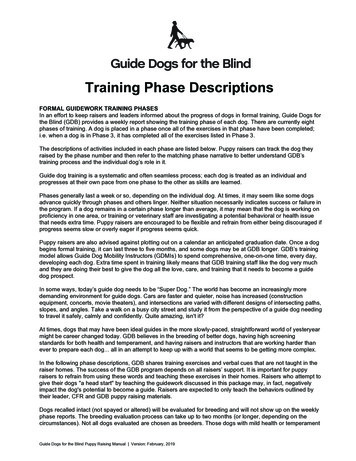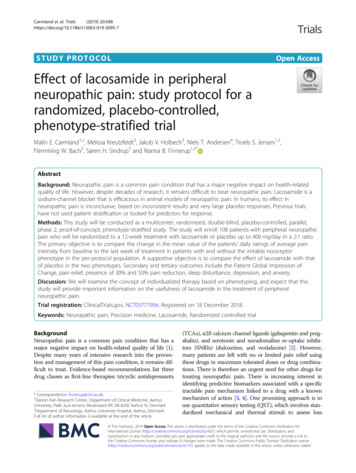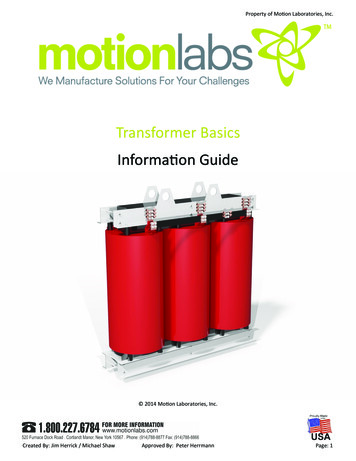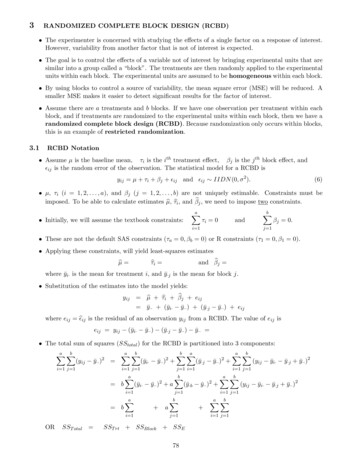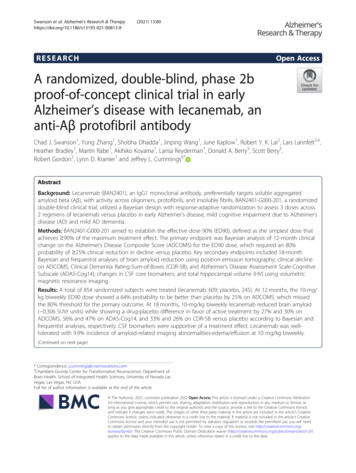
Transcription
Swanson et al. Alzheimer's Research & 2021) 13:80RESEARCHOpen AccessA randomized, double-blind, phase 2bproof-of-concept clinical trial in earlyAlzheimer’s disease with lecanemab, ananti-Aβ protofibril antibodyChad J. Swanson1, Yong Zhang1, Shobha Dhadda1, Jinping Wang1, June Kaplow1, Robert Y. K. Lai2, Lars Lannfelt3,4,Heather Bradley1, Martin Rabe1, Akihiko Koyama1, Larisa Reyderman1, Donald A. Berry5, Scott Berry5,Robert Gordon2, Lynn D. Kramer1 and Jeffrey L. Cummings6*AbstractBackground: Lecanemab (BAN2401), an IgG1 monoclonal antibody, preferentially targets soluble aggregatedamyloid beta (Aβ), with activity across oligomers, protofibrils, and insoluble fibrils. BAN2401-G000-201, a randomizeddouble-blind clinical trial, utilized a Bayesian design with response-adaptive randomization to assess 3 doses across2 regimens of lecanemab versus placebo in early Alzheimer’s disease, mild cognitive impairment due to Alzheimer’sdisease (AD) and mild AD dementia.Methods: BAN2401-G000-201 aimed to establish the effective dose 90% (ED90), defined as the simplest dose thatachieves 90% of the maximum treatment effect. The primary endpoint was Bayesian analysis of 12-month clinicalchange on the Alzheimer’s Disease Composite Score (ADCOMS) for the ED90 dose, which required an 80%probability of 25% clinical reduction in decline versus placebo. Key secondary endpoints included 18-monthBayesian and frequentist analyses of brain amyloid reduction using positron emission tomography; clinical declineon ADCOMS, Clinical Dementia Rating-Sum-of-Boxes (CDR-SB), and Alzheimer’s Disease Assessment Scale-CognitiveSubscale (ADAS-Cog14); changes in CSF core biomarkers; and total hippocampal volume (HV) using volumetricmagnetic resonance imaging.Results: A total of 854 randomized subjects were treated (lecanemab, 609; placebo, 245). At 12 months, the 10-mg/kg biweekly ED90 dose showed a 64% probability to be better than placebo by 25% on ADCOMS, which missedthe 80% threshold for the primary outcome. At 18 months, 10-mg/kg biweekly lecanemab reduced brain amyloid( 0.306 SUVr units) while showing a drug-placebo difference in favor of active treatment by 27% and 30% onADCOMS, 56% and 47% on ADAS-Cog14, and 33% and 26% on CDR-SB versus placebo according to Bayesian andfrequentist analyses, respectively. CSF biomarkers were supportive of a treatment effect. Lecanemab was welltolerated with 9.9% incidence of amyloid-related imaging abnormalities-edema/effusion at 10 mg/kg biweekly.(Continued on next page)* Correspondence: jcummings@cnsinnovations.com6Chambers-Grundy Center for Transformative Neuroscience, Department ofBrain Health, School of Integrated Health Sciences, University of Nevada LasVegas, Las Vegas, NV, USAFull list of author information is available at the end of the article The Author(s). 2021, corrected publication 2022 Open Access This article is licensed under a Creative Commons Attribution4.0 International License, which permits use, sharing, adaptation, distribution and reproduction in any medium or format, aslong as you give appropriate credit to the original author(s) and the source, provide a link to the Creative Commons licence,and indicate if changes were made. The images or other third party material in this article are included in the article's CreativeCommons licence, unless indicated otherwise in a credit line to the material. If material is not included in the article's CreativeCommons licence and your intended use is not permitted by statutory regulation or exceeds the permitted use, you will needto obtain permission directly from the copyright holder. To view a copy of this licence, visit http://creativecommons.org/licenses/by/4.0/. The Creative Commons Public Domain Dedication waiver )applies to the data made available in this article, unless otherwise stated in a credit line to the data.
Swanson et al. Alzheimer's Research & Therapy(2021) 13:80Page 2 of 14(Continued from previous page)Conclusions: BAN2401-G000-201 did not meet the 12-month primary endpoint. However, prespecified 18-monthBayesian and frequentist analyses demonstrated reduction in brain amyloid accompanied by a consistent reductionof clinical decline across several clinical and biomarker endpoints. A phase 3 study (Clarity AD) in early Alzheimer’sdisease is underway.Trial registration: Clinical Trials.gov NCT01767311.Keywords: Alzheimer’s disease, Amyloid, Lecanemab, BAN2401, Clinical trial, Biomarker, ADCOMS, Amyloid PET,Neurofilament light, Neurogranin, p-tauIntroductionAlzheimer’s disease (AD) is a progressive neurodegenerative disease that slowly impairs cognition and function [1–3]. AD occurs on a continuum, progressing from asymptomatic preclinical AD, to mild cognitive impairment dueto AD, and to mild, moderate, and severe AD dementia.Amyloid β protein (Aβ) exists in various conformationalstates, including soluble monomers, soluble aggregates ofincreasing size (e.g., oligomers, protofibrils), and insolublefibrils and plaque [4–6]. Soluble Aβ aggregates have beenshown to be more toxic than monomers or insoluble fibrils [4, 6–10], and we hypothesized that reducing thesesoluble Aβ aggregates could represent an effective treatment approach in early stages of AD [4, 11, 12].Lecanemab (BAN2401) is a humanized IgG1 monoclonal antibody that binds to soluble Aβ aggregates (oligomers and protofibrils) with high selectivity overmonomer ( 1000-fold) and insoluble fibrils (approximately 10–15 fold) [13–16]. Reduction of Aβ protofibrilsand Aβ plaque, as well as prevention of Aβ depositionbefore plaques develop, has been demonstrated usingthe murine version of lecanemab in animal models [12–14, 17, 18]. The antibody was well tolerated in a phase 1study, with dose proportional exposure [19]. On thebasis of these findings, a phase 2b proof-of-concept,dose-ranging efficacy study using a novel Bayesian adaptive design was initiated to assess the effects of lecanemab in subjects with mild cognitive impairment due toAD and mild AD dementia, collectively termed earlyAlzheimer’s disease.BAN2401-G000-201 (Study 201) employed a Bayesianadaptive design with response adaptive randomization,involving frequent blinded interim analyses intended toassess for early success or futility, and designed to update subsequent subject allocation probabilities based onthe predicted 12-month outcome modeled on all available clinical data on the Alzheimer’s Disease CompositeScore (ADCOMS). In this design, a computer algorithmassessed accumulating ADCOMS data to allocate moresubjects to a dose or doses that were most likely to bethe ED90 target dose (defined as the simplest treatmentgroup that achieves at least 90% of the modeled maximum treatment effect), while putting fewer subjects onless effective doses (NOTE: once subjects were randomized to a dose, they stayed on that dose for the durationof the study). Each interim analysis and the resulting update to subject allocation was implemented seamlesslywhile remaining completely blinded to subjects, sites,and the Sponsor. The choice of design was deemed asuitable approach to efficiently balance the desired potential for rapid decision-making and the need to establish clinical proof-of-concept [20]. The use of Bayesianmethodology with a 12-month primary endpoint in this18-month study was intended to afford the opportunityto move as early as possible into phase 3 if an earlyrigorous success criterion was met at any interim analysis, or to simply proceed per protocol to fullrandomization and study completion at 18 months if thiscondition was not met. Understanding the importanceof 18-month data in the context of AD clinical trialsassessing slowing of disease progression, all randomizedsubjects were to complete the full 18 months of treatment. The study was prospectively designed to analyzethe 18-month results with Bayesian and frequentist (conventional) statistics regardless of whether the primaryendpoint was met at 12 months.MethodsDesignA full, detailed manuscript on the lecanemab Study 201design has been previously published [20] and additionaldetails can be found in the study protocol (supplementary appendix A). Study 201 (NCT01767311) was an 18month, multicenter, double-blind, placebo-controlledBayesian design clinical trial employing response adaptive randomization across placebo and five lecanemabarms (2.5 mg/kg biweekly, 5 mg/kg monthly, 5 mg/kg biweekly, 10 mg/kg monthly, 10 mg/kg biweekly) to assesssafety and efficacy in subjects with early Alzheimer’s disease (Fig. 1). To maintain the blind, all subjects receivedbiweekly infusions of either placebo or lecanemab.Following a fixed randomization period for the first196 subjects (N 56 on placebo; N 28 in each lecanemab arm), response-adaptive randomization was implemented where dose allocation probabilities were updatedat each blinded interim analysis, conducted every 50
Swanson et al. Alzheimer's Research & Therapy(2021) 13:80Page 3 of 14Fig. 1 Lecanemab Study 201 study design. Study 201 (NCT01767311) was an 18-month, multicenter, double-blind, placebo-controlled Bayesiandesign clinical trial employing response adaptive randomization across placebo and five lecanemab arms (2.5 mg/kg biweekly, 5 mg/kg monthly,5 mg/kg biweekly, 10 mg/kg monthly, 10 mg/kg biweekly) to assess safety and efficacy in subjects with early Alzheimer's disease. At the first threeinterim analyses, if there is a .5% posterior probability that the most likely ED90 is superior to placebo by the (clinically significant difference; 25%),the trial will stop early for futility. Beginning at the 350-subject IA, and continuing to completion of the trial, the futility criterion is increased to7.5%. Interim monitoring for early success occurs at each IA beginning when 350 subjects have been enrolled. At this point, if enrollment were tostop for early success, enough subjects would be available to complete the trial so that the full dose response could be modeled. If there is a.95% posterior probability that the most likely ED90 is better than placebo by the CSD, then early success is declared. Enrollment is stopped, butall randomized subjects continue for the full 18-month duration of the study. If the trial is not stopped early for futility or success, then trialsuccess is evaluated at the completion of the trial when both accrual and follow-up for the primary endpoint are complete. At that time, if thereis a .80% probability that the most likely ED90 is better than placebo by the CSD, the trial will be considered a success. R, randomizationrandomized subjects until the approximate target of 800subjects were randomized (196, 250, 300, 350, , 800),with the remaining 56 randomized subjects allocated according to the probabilities determined at the 800 subject interim analysis. The Bayesian design aimed toidentify the effective dose 90% (ED90), defined as thesimplest dose that achieves 90% of the maximum treatment effect, and to allocate more subjects to the mostlikely ED90 dose(s) at each interim analysis [19]. “Simplest” means the earliest in the order of convenience (5mg/kg monthly, 10 mg/kg monthly, 2.5 mg/kg biweekly,5 mg/kg biweekly, 10 mg/kg biweekly). Monitoring forfutility was initiated at the first interim analysis (IA) andwas based on the dose identified as the most likelyED90. The trial would have stopped early for futility atany of the first three IAs if there was a 5% posteriorprobability that the most likely ED90 is superior to placebo by the clinically significant difference (25%). Fromthe 350-subject IA until the completion of the trial, thefutility criterion was increased to 7.5%. Interimmonitoring for early success occurred at each IA beginning when 350 subjects had been enrolled, where a .95%posterior probability that the most likely ED90 is betterthan placebo by the CSD was required. The trial was designed to continue to full completion if neither futilitynor early success was achieved according to criteria. Atfull study completion, the study was considered a success if an 80% probability that the most likely ED90 wasbetter than placebo by the CSD was achieved. In thisphase 2 trial, success is defined as a drug effect that exceeds the placebo rate by 25%, rather than only beingsuperior to placebo. We chose this criterion to ensurethat any early signal of success would likely indicate arobust treatment effect [20]. Upon full randomization,three additional interim analyses were implemented at3-month intervals from the time of the last subject randomized to assess for early success or futility prior tothe final 12-month Bayesian analysis. Subjects remainedon the assigned dose/regimen throughout the trial. Theadaptive randomization probability for placebo mirrors
Swanson et al. Alzheimer's Research & Therapy(2021) 13:80the probability for the most likely ED90 dose. Details onadaptive randomization probabilities are found in theSimulation Plan provided in the supplemental appendixB. The Bayesian computer algorithm was finalized priorto study start (i.e., not modified during the course of thestudy). ADCOMS, a score generated from 12 items collected with 3 well-established clinical scales [21], wasemployed as a sensitive measure of clinical decline inearly Alzheimer’s disease intended to aid in drivingresponse-adaptive subject allocation. The trial was approved by the institutional review board or independentethics committee at each center and all subjects provided informed consent.There was a notable protocol amendment duringthe course of the study related to a safety observationfor apolipoprotein E4 (ApoE4) gene carriers receivingthe highest dose of lecanemab. Emerging data fromthe study just prior to the 350 subject interim analysis indicated that ApoE4 positive homozygous individuals on the highest dose of lecanemab (10 mg/kgbiweekly) had the highest risk of developing symptomatic amyloid-related imaging abnormalities-edema/effusion (ARIA-E). Following comprehensive data review, one regulatory authority requested that ApoE4carriers (homozygous and heterozygous; approximately70% of the overall subject population) no longer beadministered the 10 mg/kg biweekly dose of lecanemab going forward, and this approach was adoptedfor all subsequent randomizations. At the same time,a request was made to discontinue from study drugadministration, without exception, all ApoE4 carriers(homozygous and heterozygous) who were randomized to the 10 mg/kg biweekly dose and were onstudy for less than 6 months. Additional details areavailable in Supplementary Appendix C.SubjectsParticipants comprised 2 subgroups: mild cognitiveimpairment due to AD or mild AD dementia. Allsubjects were confirmed amyloid positive via amyloidpositron emission tomography (PET) or cerebrospinalfluid (CSF) Aβ1–42 for eligibility. Key inclusion criteriaincluded objective impairment in episodic memory(on Wechsler Memory Scale-IV Logical Memory II[WMS-IV LMII]), Mini Mental State Examination(MMSE) score equal to or greater than 22 at screening and baseline (amended to MMSE 22–28 in EU,except Italy), and naïve to or on stable dose (12weeks) of approved AD medications.Endpoints and assessmentsThe primary endpoint was change from baseline at 12months on ADCOMS [20]. Key secondary endpointswere change from baseline at 18 months in brainPage 4 of 14amyloid by PET Standard Uptake Value ratio (SUVr) inan optional sub-study of consenting participants,ADCOMS, Clinical Dementia Rating-Sum-of-Boxes(CDR-SB), Alzheimer Disease Assessment ScaleCognitive Subscale (ADAS-Cog14), CSF biomarkers (optional sub-study), and total hippocampal volume usingvolumetric magnetic resonance imaging (vMRI). Anevaluation of the efficacy of lecanemab compared to placebo at 18 months for ADCOMS, CDR-SB, and ADASCog14 within the mild cognitive impairment due to AD(MCI) and mild AD dementia clinical subgroups wasalso a key secondary endpoint. Subjects were monitoredfor adverse events at all visits. All subjects with ARIA-Eas assessed by MRI were discontinued immediately perprotocol, regardless of radiologic severity or symptomatic status. ADCOMS, ADAS-Cog14, CDR-SB, andMMSE were collected every 3 months during the study.CSF samples were collected in consenting participants atbaseline, 12, and 18 months, with biomarkers (Aβ1–42,phosphorylated tau [p-tau], total tau [t-tau] as well asexploratory biomarkers, including neurogranin, and neurofilament light chain [NfL]) measured by ELISA andSIMOA. Additional details can be found in the studyprotocol (supplementary appendix A).Statistical analysesBayesian dose-response data for the primary endpointwere modeled with a 2-dimensional (dose-by-frequency)first-order normal dynamic linear model, where Normaland Inverse-Gamma priors were used. The primary endpoint was met if the Bayesian analysis, when all subjectscompleted 12 months of treatment, met the threshold ofan 80% probability that the ED90 dose achieved at least25% less clinical decline compared to placebo onADCOMS. This proof-of-concept study was powered fordecline on active treatment being at least 25% less thandecline on placebo, which was defined as the clinicallysignificant difference (CSD) for this study. The 12month primary analysis was intended to allow for theopportunity to accelerate decision making for phase 3. Asample size of approximately 800 subjects was deemedsufficient to meet the 80% probability threshold for theprimary endpoint according to treatment-response assumptions [19].Bayesian and conventional (frequentist) statistical analyses were prospectively defined prior to study start forkey secondary endpoints (change from baseline for thetreatment groups compared to placebo at 18 months forPET SUVr, ADCOMS, ADAS-Cog14, CDR-SB, vMRI,and CSF biomarkers). Bayesian analyses did not requireadjustment for multiplicity by nature of the Bayesian approach. Conventional analyses were performed using amixed effects model with repeated measures (MMRM)comparing placebo to active arms. All listed p-values for
Swanson et al. Alzheimer's Research & Therapy(2021) 13:80key secondary endpoints using conventional statisticsare nominal, and no correction was applied for multiplicity. In addition to analyses for individual dose arms, aprospectively defined analysis of key secondary endpoints was performed on subjects from the combinedtwo 10 mg/kg dose regimens, in an attempt to balancethe number of ApoE4-positive subjects lost in the 10mg/kg biweekly dose group brought about by the Regulatory Authority-imposed amendment to the design. TheMMRM analysis used treatment group, visit, clinicalsubgroup (MCI due to AD, Mild AD dementia), thepresence or absence of ongoing AD treatment at baseline, ApoE4 status, world region, and treatment groupby-visit interaction as factors, and baseline value as covariate. Safety assessments were summarized by treatment group using descriptive statistics. There was nosample size analysis for the CSF substudy and results forbiomarker analyses are presented descriptively. Subjectsfrom the 10 mg/kg biweekly and monthly doses werepooled in the CSF substudy biomarker analyses to increase the sample size.Page 5 of 14Role of the funding sourceThis trial was funded by Eisai Inc. Authors from EisaiInc. had input into the study design; in the collection,analysis, and interpretation of data; in the writing of thereport; and in the decision to submit the paper for publication. The corresponding author had full access to allthe data in the study and had final responsibility for thedecision to submit for publication.ResultsA total of 856 subjects were randomized and 854 weretreated (lecanemab, 609; placebo, 245) between December 2012 and November 2017 at 117 sites across NorthAmerica (the USA and Canada), Europe (France,Germany, Italy, Netherlands, Spain, Sweden, and theUK), and the Asia-Pacific region (Japan and SouthKorea).Allocation of subjects to doses via the adaptiverandomization design are shown in Fig. 2. The adaptiverandomization algorithm identified both 10 mg/kg biweekly and 10 mg/kg monthly early in the study asFig. 2 Randomization allocations by treatment group per protocol-defined interim analyses. The response adaptive randomization correctlyallocated subjects into the dose groups likely to be ED90 doses (10 mg/kg monthly and biweekly) as early as the first interim analysis at 197subjects, with both emerging by the 300th subject randomized, and these doses remained the most likely doses to demonstrate efficacythroughout the remainder of the study. However, before the interim analysis of 350 subjects, Health Authorities restricted randomization aroundApoE4 carrier status, whereby ApoE4 carriers (hetero- or homozygous) were not to be randomized to the 10 mg/kg biweekly dose going forward.As a consequence, the response adaptive randomization algorithm was revised. After each subsequent interim analysis (starting with 350 subjectsrandomized), the randomization probability vector was split between ApoE4 carrier and non-carrier strata to ensure no ApoE4 carriers wereenrolled on the 10 mg/kg biweekly dose (more details in Appendix C). At the same time, the revised response adaptive randomization preservedthe overall randomization probabilities
Swanson et al. Alzheimer's Research & Therapy(2021) 13:80Page 6 of 14potential ED90 doses, and they received the greatest allocation of subjects accordingly. The number of subjectsrandomized per dose were placebo 247; 2.5 mg/kg biweekly 52; 5 mg/kg monthly 51; 5 mg/kg biweekly 92; 10 mg/kg monthly 253; 10 mg/kg biweekly 161(Fig. 2). Although the lecanemab 10 mg/kg biweekly dosewas identified as the target ED90 dose, it did not receivethe highest number of subjects since randomization ofApoE4 carriers (approximately 70% of the subject population) to this dose was prohibited per implementation ofthe Regulatory Authority request imposed between theperiod of 300 and 350 randomized subjects. As a result,the lecanemab 10 mg/kg biweekly group had fewer subjects compared to 10 mg/kg monthly with a lower percentage of ApoE4 carriers (30%) relative to all othertreatment groups (placebo 71%; 2.5 mg/kg biweekly 73%;5 mg/kg monthly 77%; 5 mg/kg biweekly 91%; 10 mg/kgmonthly 89%). Demographic and baseline characteristicswere otherwise similar among treatment groups, with theexception of more male subjects in the lecanemab grouprelative to placebo (54% vs 42%; Table 1). Baseline characteristics for completers and discontinued subjects arecomparable across treatments for each group and can befound in Tables S1-S2.Discontinuations occurred in 23.7% for placebo- and36.0% for lecanemab-treated subjects. Lecanemabdiscontinuations were largely driven by ARIA-E events,which resulted in discontinuation per protocol (N 48,46 lecanemab [1 for 2.5 mg/kg biweekly, 1 for 5 mg/kgmonthly, 3 for 5 mg/kg biweekly, 25 for 10 mg/kgmonthly, 16 for 10 mg/kg biweekly], 2 placebo) and byimplementation of the aforementioned Regulatory Authority request requiring discontinuation of subjectswho were ApoE4 carriers and who were on 10 mg/kglecanemab biweekly for less than 6 months (n 25).Discontinuations due to non-ARIA-E adverse eventswere similar between placebo and lecanemab. Additional information can be found in the Supplementary Appendix (Figure S1).EfficacyThe Bayesian model identified 10 mg/kg biweekly as theeffective dose 90% (ED90), defined as the simplest dosethat achieves 90% of the maximum treatment effect, atthe 12-month final Bayesian analysis (Table 2). The primary analysis conducted at month 12 of treatment forall subjects indicated that the 10 mg/kg biweekly (ED90)dose had a 64% probability of being better than placebowith 25% less decline on ADCOMS at 12 months, missing the pre-specified 80% probability threshold for theprimary outcome (Table 2). As such, the primary endpoint was not met. Prespecified Bayesian analysis at 18Table 1 Baseline characteristics. Baseline characteristics were reasonably well balanced across doses for each category, with theexception of ApoE4 status. The imbalance in ApoE4 status on the 10 mg/kg monthly and 10 mg/kg biweekly doses is directly relatedto the change in study design brought about by Health Authority interactionsCategoryLecanemabAge, median (range), yearsPlacebo2.5 mg/kgbiweekly5 mg/kgmonthly5 mg/kgbiweekly10 mg/kgMonthly10 mg/kgbiweeklyTotalLecanemab(N 238)(N 52)(N 48)(N 89)(N 246)(N 152)(N 587)71 (55–84)72 (52–87)71 (53–90)73 (51–88)72 (50–90)72 (50–89) 71 (50–86)Female, n (%)137 (58)26 (50)24 (50)48 (54)110 (45)64 (42)272 (46)CDR Global 0.5200 (84)44 (85)40 (83)77 (87)210 (85)133 (88)504 (86)Mild cognitive impairment154 (65)34 (65)33 (69)52 (58)166 (68)90 (59)375 (64)ApoE4 positive169 (71)38 (73)37 (77)81 (91)218 (89)46 (30)420 (72)Ongoing treatment with AChEIs and/or memantine128 (54)28 (54)25 (52)56 (63)131 (53)79 (52)319 (54)ADCOMS, mean (SD)0.37 (0.17) 0.39 (0.20)0.40 (0.17)0.39 (0.16)0.37 (0.15)0.37 (0.15)0.38 (0.16)ADAS-Cog14, mean (SD)22.6 (7.7)22.7 (8.1)22.9 (7.7)22.8 (6.7)21.9 (7.3)22.1 (7.7)22.2 (7.4)CDR-SB, mean (SD)2.9 (1.5)3.0 (1.6)2.9 (1.4)3.0 (1.3)2.9 (1.3)3.0 (1.4)3.0 (1.4)MMSE, mean (SD)26.0 (2.3)25.7 (2.5)PET SUVr, mean (SD)†1.40 (0.16) 1.41 (0.11)*25.3 (2.6)25.6 (2.3)25.7 (2.4)25.6 (2.4)25.6 (2.4)1.42 (0.17)1.40 (0.12)1.42 (0.18)1.37 (0.16)1.41 (0.16)CDR, Clinical Dementia Rating; ApoE4, apolipoprotein E4; AChEIs, acetylcholinesterase inhibitors; ADCOMS, the Alzheimer’s Disease Composite Score; ADAS-Cog14,Alzheimer’s disease Assessment Scale-Cognitive Subscale; CDR-SB, Clinical Dementia Rating-Sum-of-Boxes; MMSE, Mini Mental State Examination; PET SUVr,positron emission tomography standard uptake value ratio*In the ADAS-Cog14 assessment, there were 237 subjects in the placebo group and 586 in the total lecanemab group (2.5 mg/kg biweekly 52; 5 mg/kgmonthly 47; 5 mg/kg biweekly 89; 10 mg/kg monthly 246; 10 mg/g biweekly 152)†In the PET sub-study, there were 99 subjects in the placebo group and 216 in the total lecanemab group (2.5 mg/kg biweekly 28; 5 mg/kg monthly 28; 5 mg/kg biweekly 27; 10 mg/kg monthly 89; 10 mg/g biweekly 44)
Swanson et al. Alzheimer's Research & Therapy(2021) 13:80Page 7 of 14Table 2 Bayesian Analysis of ADCOMS at 12 months—full analysis setTreatment groupTotal NChange from baselinePosterior quantities*MeanSDPr (Max)Pr (ED90)Pr SuperiorityPr (CSD)ADCOMS—overallPlacebo control2290.1130.012––––2.5 mg/kg biweekly510.1340.0240.0090.0090.2160.0285 mg/kg monthly480.1190.0210.0220.0310.4160.0705 mg/kg biweekly870.1160.0160.0100.0100.4460.05310 mg/kg monthly2420.0840.0110.3180.3860.9610.47910 mg/kg biweekly1430.0770.0140.6420.5630.9760.638Only subjects with non-missing data at both baseline and the relevant post-baseline visit are included in the change from baseline summary statisticsADCOMS, Alzheimer’s Disease Composite Score; CSD, clinically significant difference; 25% better than placebo, ED90, dose regimen with at least 90% of the dmaxtreatment effect; Max, maximum treatment effect; Pr, probability; Pr (Max), probability of being maximal effective dose; Pr (ED90), probability of being the ED90dose; Pr (Superiority), probability to be superior to placebo by any magnitude; Pr (CSD), probability to be better than placebo by at least 25%*Probabilities can be interpreted as a percentage (e.g., 0.10 is 10%)months determined that the lecanemab 10 mg/kg biweekly dose had a 76% probability of being better thanplacebo by 25% less decline on ADCOMS (Table S2).Despite 10 mg/kg biweekly not having achieved thethreshold needed for superiority over placebo by at least25%, additional prespecified Bayesian analyses indicateda 97.6% and 97.7% probability of being superior to placebo by any magnitude at both 12 and 18 months,respectively.All reported p values are considered nominal because the primary endpoint was not met. Dosedependent reductions in amyloid PET SUVr valueswere observed using florbetapir as the imaging agentand whole cerebellum as reference region (Fig. 3a).Binary (positive/negative) amyloid PET visual readanalyses indicated results consistent with SUVr data(Fig. 3b). Least squares (LS) mean changes from baseline in amyloid PET SUVr normalized to whole cerebellum mask at 18 months were 0.004 for placebo,and 0.094, 0.131, 0.197, 0.225, and 0.306 forlecanemab 2.5 mg/kg biweekly, 5 mg/kg monthly, 5mg/kg biweekly, 10 mg/kg monthly, and 10 mg/kg biweekly groups, respectively. The respective LS meandifferences from placebo for the individual lecanemabtreatment groups were 0.099, 0.136, 0.201, 0.229,and 0.310 (P 0.001 for all doses).Fig. 3 Change from baseline in brain amyloid pathophysiology. Results as measured by amyloid PET SUVr are shown in a. Outcomes from thequalitative (binary) visual read of the PET scans for conversion of brain amyloid pathology from positive to negative are depicted in b. *P 0.05,**P 0.01, ***P 0.001, ****P 0.0001 (all nominal). For PET analysis, N 306 at 12 months and N 288 at 18 months. The PET substudy wasoptional, so only a portion of the total enrolled subject population opted to participate
Swanson et al. Alzheimer's Research & Therapy(2021) 13:80The results for the Bayesian analyses for reduction ofclinical decline at 18 months compared to placebo for10 mg/kg biweekly on ADCOMS (27%; with 97.7% probability to be superior to placebo), CDR-SB (33%; with96.4% probability to be superior to placebo), and ADASCog14 (56%, with 98.8% probability to be superior toplacebo) were similar to the results from the corresponding frequentist analyses for clinical measures whencomparing mean change from baseline and LS meandata (additional data found in Tables S3, S4, S5, S6, S7,S8, S9). Figure 4 shows the time course of effects according to frequentist analyses for ADCOMS, CDR-SB, andADAS-Cog14 at the two doses the Bayesian algorithmdetermined to be the mo
better than placebo by the CSD was achieved. In this phase 2 trial, success is defined as a drug effect that ex-ceeds the placebo rate by 25%, rather than only being superior to placebo. We chose this criterion to ensure that any early signal of success would likely indicate a robust treatment effect [20]. Upon full randomization,
